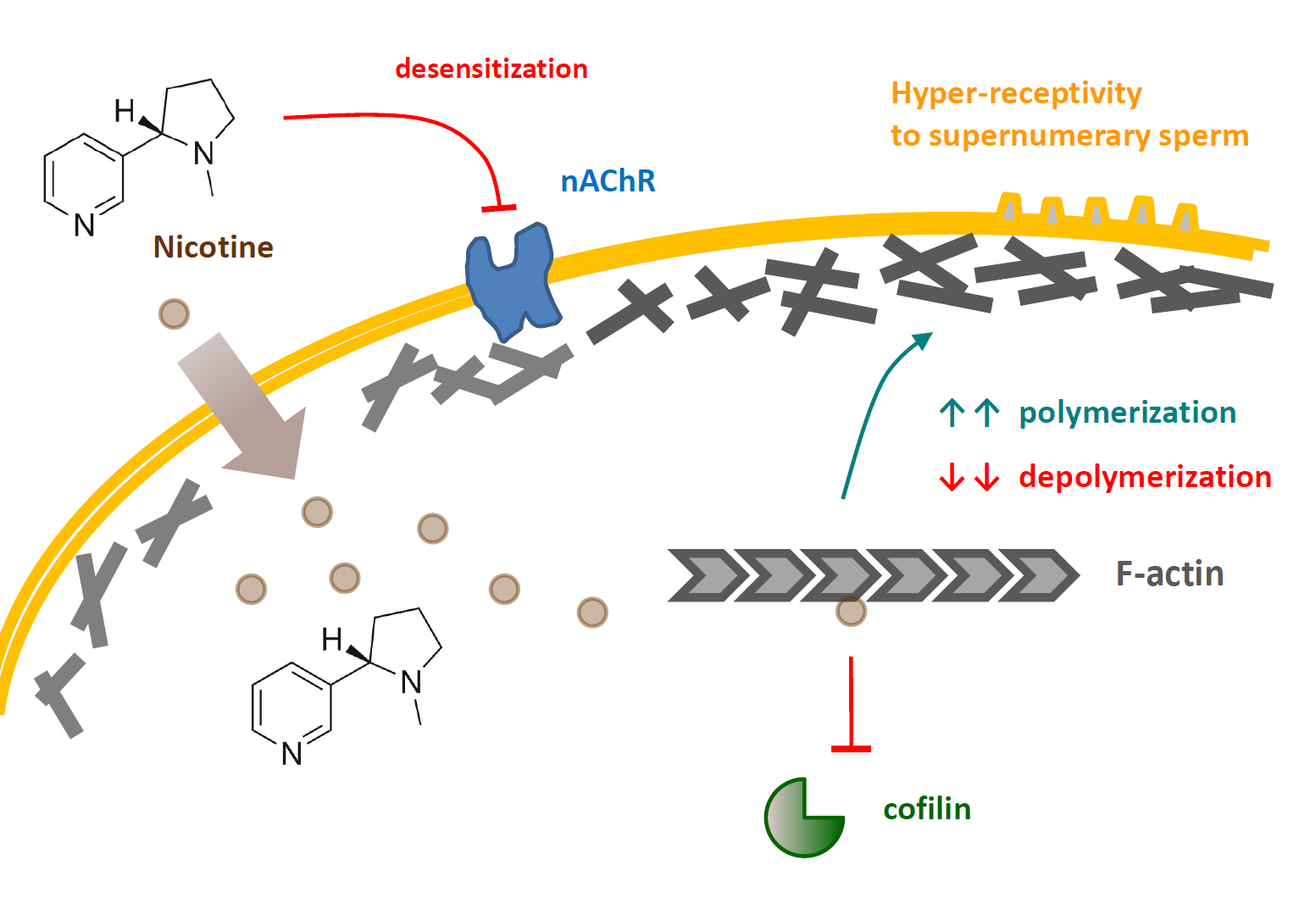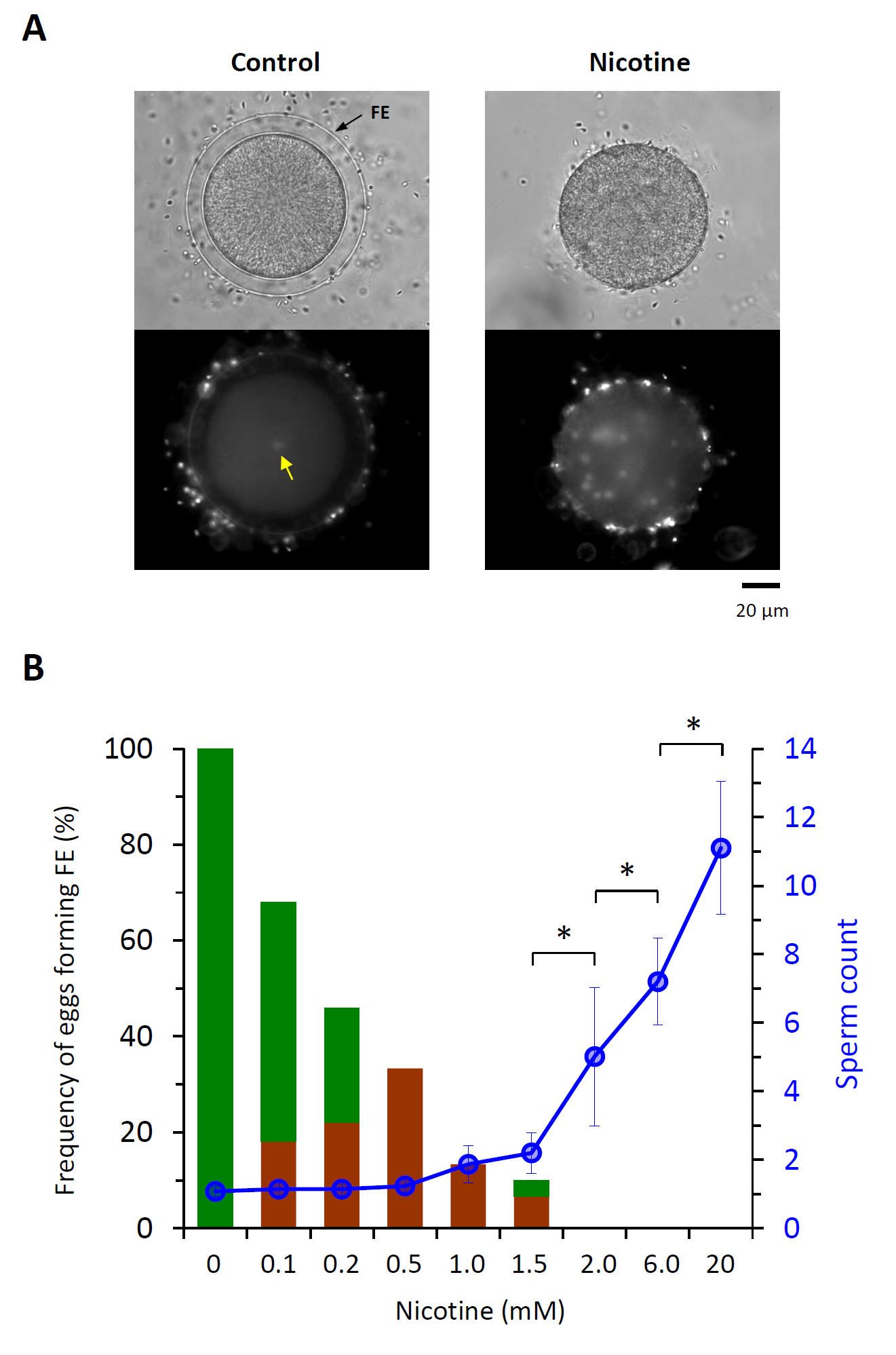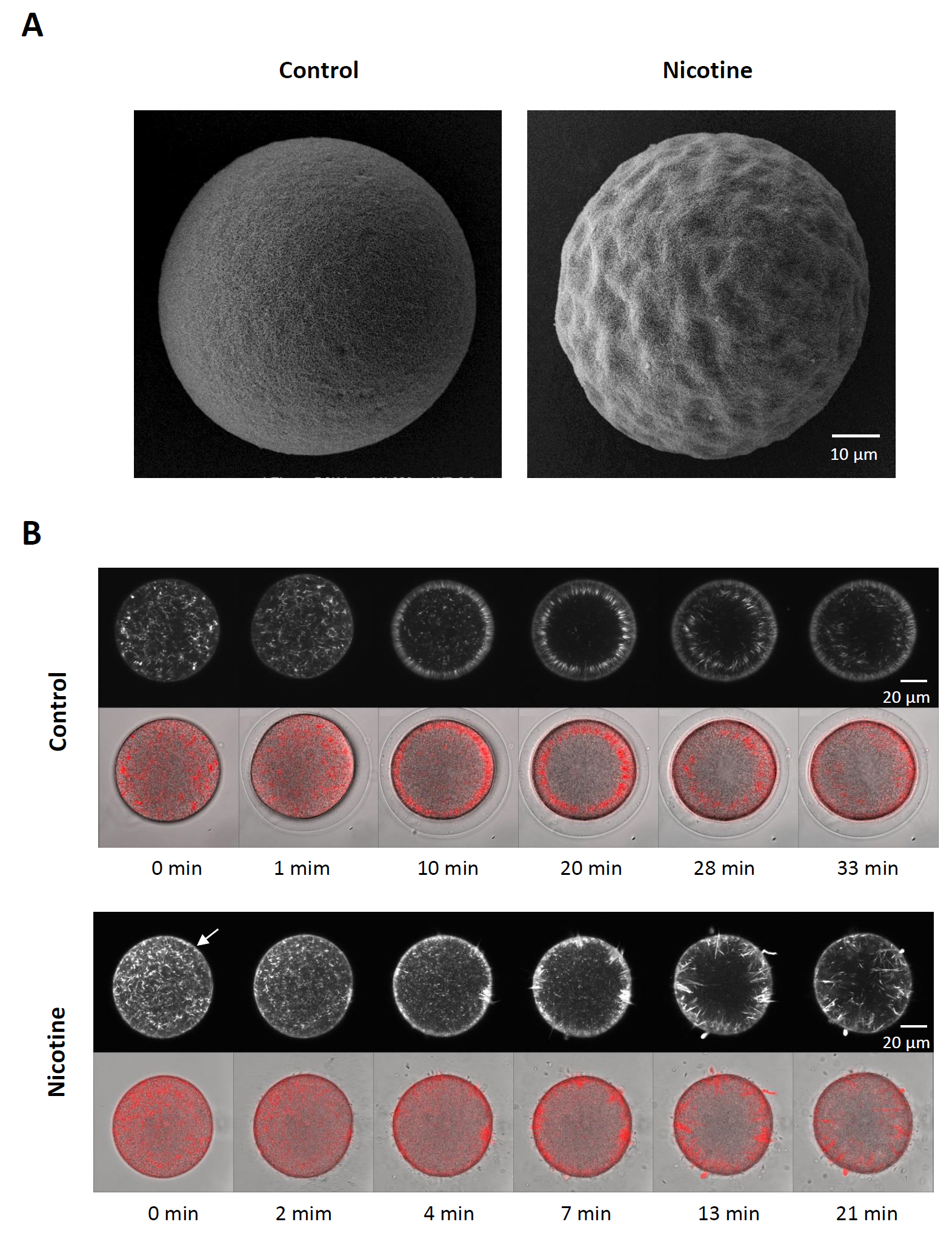Even in the experimental conditions involving high sperm density, sea urchin eggs impressively manifest monospermic fertilization almost all the time, which led to the notion that there is a mechanism preventing polyspermic fertilization. Our previous studies with starfish and sea urchin repeatedly indicated that exquisite control of the actin cytoskeleton in the egg is accountable for monospermic fertilization1-3. In the present study, we tested this hypothesis. It has long been known that nicotine induces high rates of polyspermic fertilization in sea urchin4. Given that, does the nicotine-induced polyspermy also involve deregulation of the egg actin cytoskeleton? What could be the underlying mechanism for this? Since nicotine acts as an agonist on ionotropic receptors for acetylcholine (ACh), which is the first known neurotransmitter, we suspected that activation of a signaling pathway involving nicotinic ACh receptor (nAChR) might cause polyspermy. To our surprise, however, the results of our experiments performed in the numerous past breeding seasons consistently indicated that nAChR has nothing to do with nicotine-induced polyspermy in sea urchin eggs at fertilization. The agonists of nAChR did not mimic the effect of nicotine, and the inhibitors of nAChR failed to alleviate nicotine-induced polyspermy. Instead, inhibitors of actin polymerization did so. Our data thus suggest that nicotine may pass through the egg plasma membrane and directly act on the subplasmalemmal F-actin meshwork to change its polymerization dynamics, structure, and functionality, and thereby enhance egg’s sperm-receptivity5.
Furthermore, the results of this article have raised several important points to consider:
[1] The number of egg-incorporated sperm proportionally increases with the dose of nicotine in the media.
[2] Nicotine inhibits formation of the fertilization envelope, but that is not correlated with the number of egg-incorporated sperm.
[3] A few minutes’ exposure of eggs to nicotine induces hyperpolymerization of the suboolemmal actin in a dose-dependent manner.
[4] Microinjected nicotine, but not the agonists of nAChR, induces F-actin changes and polyspermy.
[5] Nicotine alters topography of egg surface, creating numerous concaves.
[6] In test tubes, polymerization kinetics of actin is accelerated by nicotine, while its depolymerization kinetics is inhibited.
[7] Nicotine inhibits the actin-depolymerizing action of cofilin in test tube. Thus, the net effect of nicotine is promotion of actin polymerization.
Most importantly, the finding that nicotine has profound effects on the cytoskeletal structure and the physiology of sea urchin eggs suggests that this familiar alkaloid, nicotine, may have more extensive effects on animal cells in diverse unknown pathways.

Figure 1. Proposed model for the mechanism of nicotine-induced polyspermy. Nicotinic acetylcholine receptors (nAChR) may exist on the egg surface, but nicotine bypasses or even desensitizes them. A majority of nicotine in its unprotonated form permeates the cell membrane and change the structure and function of the actin cytoskeleton. This could be achieved either directly acting on actin molecules or interfering with actin-binding proteins such as cofilin. As a result, proper regulation of the egg actin cytoskeleton fails, and this leads to supernumerary sperm entry at fertilization.

Figure 2. Nicotine induces polyspermy in a dose-dependent manner. (A) Bright field view and the epifluorescence photomicrographs (bottom) showing the control egg and the egg exposed to 6 mM nicotine prior to fertilization. Whereas a single sperm entered the control egg (yellow arrow), numerous sperm were incorporated into the nicotine-exposed eggs. (B) Quantification of the egg-incorporated sperm and the extent of FE elevation. Green bars in the histogram represent the eggs with full-fledged elevation of FE, while brown bars stand for the eggs showing thin modest elevation of the fertilization envelope (FE). U-test: #P<0.05, *P<0.01, ****P<0.00001.

Figure 3. Nicotine renders egg surface hyper-receptive to supernumerary sperm. (A) Comparison of the cell surface topography of the jelly-free eggs by scanning electron microscopy after pretreatment of the eggs in the presence or absence of 5 mM nicotine (5 min). (B) Effects of nicotine on the mobilization of cortical actin filaments following fertilization. P. lividus eggs were microinjected with AlexaFluor568-Phalloidin and subsequently incubated in the presence or absence of 20 mM nicotine for 5 min. The eggs were then fertilized in fresh natural seawater and the distribution of actin filaments were continuously monitored by confocal microscopy.
References
1. Puppo A, Chun JT, Gragnaniello G, Garante E, Santella L. (2008) Alteration of the cortical actin cytoskeleton deregulates Ca2+ signaling, monospermic fertilization, and sperm entry. PLoS One 3:e3588; doi: 10.1371/journal.pone.0003588.
2. Chun JT, Limatola N, Vasilev F, Santella L. (2014) Early events of fertilization in sea urchin eggs are sensitive to actin-binding organic molecules. Biochem Biophys Res Commun. 450:1166-74. doi: 10.1016/j.bbrc.2014.06.057.
3. Limatola N, Vasilev F, Chun JT, Santella L. (2019) Sodium-mediated fast electrical depolarization does not prevent polyspermic fertilization in Paracentrotus lividus eggs. Zygote. 27:241-249. doi: 10.1017/S0967199419000364.
4. Hertwig O, Hertwig R. (1887). Uber den Befruchtungs- und Teilungsvorgang des tierischen Eies unter dem Einfluss ausserer Agentien. Jen. Zeitschr., 20: 120.
5. Limatola N, Vasilev F, Santella L, Chun JT. (2020) Nicotine Induces Polyspermy in Sea Urchin Eggs through a Non-Cholinergic Pathway Modulating Actin Dynamics. Cells. 9(1). pii: E63. doi: 10.3390/cells9010063.










